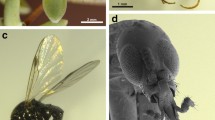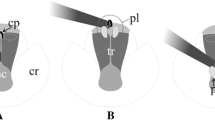Abstract
In direct contrast to mostHibbertia spp., the flowers ofH. fasciculata R. Br. ex D. C. bear only a single whorl of stamens and these stamens are arranged separately (not in typical “bundles”). The short filaments are appressed to the three carpels so that the inflated, porose and introrsive anthers form a centralized cluster obscuring the three ovaries. The three slender styles emerge at right angles from between the filaments. These styles curve upward and the stigmas form the three points of a triangle; each stigma is approximately one millimeter outside the centralized cluster of anthers. The flowers are nectarless and bear a bright yellow corolla. A pungent and unpleasant fragrance appears to be concentrated within the pollenkitt. When native bees attempt to forage for the pollen, within the cluster of anthers, the ventrally deposited loads of pollen, on the bees' abdomens, contact the outer triangle of stigmas. The major pollinators ofH. fasciculata are female bees in the polylectic genera,Lasioglossum (subgenusChilalictus, Halictidae) andLeioproctus (Colletidae). These bees carry an average of more than two pollen taxa when they are caught foraging onH. fasciculata. 78% of the 47 bees, captured onH. fasciculata carried the pollen from at least one sympatric taxon bearing nectariferous flowers (e.g., genera in theMyrtaceae, Compositae, andEpacridaceae). The pollination biology ofH. fasciculata is assessed in relation to the known radiation of bee-pollinated flowers in the genusHibbertia, and within theDilleniaceae s. l.
Similar content being viewed by others
References
Armstrong, J. A., 1979: Biotic pollination mechanisms in the Australien flora—a review. — New Zealand J. Botany17, 467–508.
Bernhardt, P., 1982: Insect pollination of AustralianAcacia. InWilliams, E. B., Knox, R. B., Gilbert, J. H., Bernhardt, P. (Eds.): Pollination '82: Proceedings of a Symposium held at the Plant Cell Biology Research Centre, pp. 84–101. — Melbourne University Press.
—, 1984: The pollination biology ofHibbertia stricta (Dilleniaceae). — Pl. Syst. Evol.147, 267–277.
—, 1984: Pollination biology and the breeding system ofAcacia retinodes (Leguminoseae:Mimosoidae). — Ann. Missouri Bot. Gard.71, 17–29.
—, 1979: The pollination ecology ofEcheandia macrocarpa (Liliaceae). — Brittonia31, 64–71.
—, 1984: Bee foraging on three sympatric species of AustralianAcacia. — Intern. J. Entomology26, 322–330.
Bowers, K. A. W., 1975: The pollination ecology ofSolanum rostratum. — Amer. J. Bot.62, 633–638.
Buchmann, S. L., 1983: Buzz pollination in angiosperms. InJones, C. E., Little, R. J., (Eds.): Handbook of Experimental Pollination Biology. — Scientific and Academic Editions, Van Nostrand Reinhold Co. Inc. U.S.A.
Corner, E. J. H., 1940: Wayside Trees of Malaya. — Singapore: Government Printing.
Cronquist, A., 1981: An Integrated System of Classification of Flowering Plants. — Columbia University Press, U.S.A.
Dickison, W. C., 1969: Comparative morphological studies inDilleniaceae. IV. Anatomy of the node and vascularization of the leaf. — J. Arnold Arbor. Harv. Univ.50, 384–410.
Faegri, K. van der Pijl, L., 1979: Principles of Pollination Ecology. 2nd ed. — Oxford and New York: Pergamon Press.
Frankie, G. W., Haber, W. A., Opler, P. A., Bawa, K. S., 1983: Characteristics and organization of the large bee pollination system in the Costa Rican dry forest. — InJones, C. E., Little, R. J., (Eds.): Handbook of Experimental Pollination Biology, pp. 411–447. — Scientific and Academic Editions, Van Nostrand Reinhold Co. Inc., U.S.A.
Free, J. B., 1970: Insect Pollination of Crops. — London and New York: Academic Press.
Haber, W. A., Bawa, K. S., 1984: Evolution inSaurauia (Dilleniaceae). — Ann. Missouri Bot. Gard.71, 289–293.
Keighery, G. J., 1975: Pollination ofHibbertia hypericoides (Dilleniaceae) and its evolutionary significance. — J. Nat. Hist.9, 681–684.
Macior, L. W., 1974: Behavioural aspects of caodaptations between flowers and insect pollinators. — Ann. Missouri Bot. Gard.61, 760–769.
Michener, C. D., 1974: The Social Behaviour of the Bees. — Cambridge, Mass., U.S.A.: Belknap Press of Havard U.
Nowicke, J. W., Meselson, M., 1984: Yellow rain—a palynological analysis. — Nature309, 205–206.
Ogden, E. C., Raynor, G. S., Hayers, J. V., Lewis, D. M., 1974: Manual of Sampling Airborne Pollen. — London: U.K.
Ornduff, R., 1969: Reproductive biology in relation to systematics. — Taxon18, 121–133.
Schneider, E., 1979: Pollination biology of theNymphaeaceae. — InCaron, D. M., (Ed.): Proceedings of the IVth International Symposium on Pollination. — Maryland Ag. Exp. Sta. Spec. Misc. Publ.1, 419–430.
Specht, R. K., Rose, E. M., Boughton, V. H., 1974: Conservation of major plant communities in Australia and Papua New Guinea. — Aust. J. Bot. Suppl. Ser.7, 1–667.
Stebbins, G. L., Hoogland, R. D., 1976: Species diversity, ecology and evolution in a primitive angiosperm genus:Hibbertia (Dilleniaceae). — Pl. Syst. Evol.125, 139–154.
Thien, L. B., Bernhardt, P., Fibbs, G. W., Pellmyr, O., Bergstrom, G., Groth, I., McPerhson, G., 1985: The pollination ofZygogynum (Winteraceae) by a moth,Sabatinca (Micropterigidae): An ancient association? — Science227, 540–543.
—, 1975: Floral odors and quantitative taxonomy ofMagnolia andLiriodendron. — Taxon24, 557–568.
Uhl, N. W., Moore, H. E., 1977: Correlations of inflorescence, flower structure and floral anatomy with pollination in some palms. — Biotropica9, 170–190.
Vogel, St., 1978: Evolutionary shifts from reward to deception in pollen flowers. — InRichards, A. J., (Ed.): The Pollination of Flowers by Insect, pp. 89–96. — Linn. Soc. Symp. No.6. — London: Academic Press.
Williams, N. H., 1983: Floral fragrances as cues in animal behavior. — InJones, C. E., Little, R. J., (Eds.): Handbook of Experimental Pollination Biology.
- Scientific and Academic Editions, Van Nostrand Reinhold Co. Inc., U.S.A.
Author information
Authors and Affiliations
Rights and permissions
About this article
Cite this article
Bernhardt, P. Bee-pollination inHibbertia fasciculata (Dilleniaceae) . Pl Syst Evol 152, 231–241 (1986). https://doi.org/10.1007/BF00989430
Received:
Issue Date:
DOI: https://doi.org/10.1007/BF00989430




